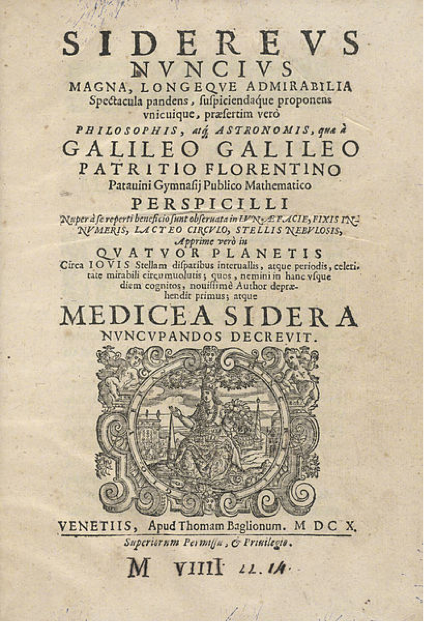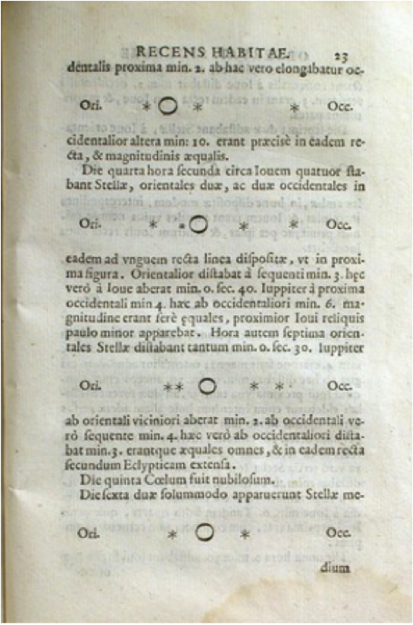This article was published in Scientific American’s former blog network and reflects the views of the author, not necessarily those of Scientific American
The paradox of 21st-century science is that increasingly complex and collaborative cutting-edge research is still being written and published using 20th-century tools.
The essential question—How come the internet age has yet to deliver a collaborative writing and publishing tool for research?—is what two of my physicist friends and I were thinking about several years ago while working at CERN, before we started Authorea. It didn’t occur to us then, but in retrospect it seems like CERN—the birthplace of the World Wide Web—was the perfect place to hatch our new idea.
Before we get into this particular story, take a look at Galileo Galilei’s seminal paper Starry Messenger (Sidereus Nuncius) below. This 400-year-old piece of observational astronomy chronicles, among other things, details of the lunar terminator, the Medicean stars (which later of course became the Galilean moons), and the array of dimmer stars present in the Ptolemaic nebulae.
On supporting science journalism
If you're enjoying this article, consider supporting our award-winning journalism by subscribing. By purchasing a subscription you are helping to ensure the future of impactful stories about the discoveries and ideas shaping our world today.

Title page of Sidereus Nuncius, 1610, by Galileo Galilei (1564-1642). Credit: Wikimedia Public Domain

Galileo's drawings of Jupiter and its Medicean Stars from Sidereus Nuncius. Credit: History of Science Collections, University of Oklahoma Libraries
Quite the publication! Does it look familiar? It’s no coincidence that even though it was published in 1610, Starry Messenger closely resembles the scholarly papers of today. For better or for worse, the scholarly paper endures as the de facto standard for dissemination of scientific ideas.
But while text and figures might have been enough for the Italian astronomer working in Padua four-hundred years ago, it’s not always sufficient for today’s scholars. Research is becoming more complex. Researchers are using advanced techniques and tools—computational or otherwise—yet the results are written, packaged, shared, and validated in a totally anachronistic way.
Some of the hot issues in science today—the crisis of reproducibility, the indignation with impact factor, the contested effectiveness of peer review, and the progressive Open Access movement – these are the symptoms of a tedious and damaged writing and publication process. Advancement requires openness and collaboration, not paywalls and submission fees.
Authorea was founded to make it easier to write and publish scholarly articles native to the web. We wanted to provide all of the writing tools that scholars today require—and to put it all in an online format that would make it easy to collaborate, share data, and publish.
We envisioned all of the things that researchers want to do as they write a paper—collaborate with co-authors, pull citations from web libraries, insert data, submit to journals—and then built it into a native web-app. Native to the web—just like our current generation of researchers!
The first order benefit would be to have a centralized workspace to write scholarly work. You would be able to write in any scholarly format (from plain text to LaTeX), cite, edit, collaborate, embed data, and so on. Each project would live in a repository to which you could invite collaborators, control versions, and publish revisions.
The second order benefit would be to have complete control of exporting, submitting, and publishing. You could write from templates, output to hundreds of journal styles, and publish a live version of your research directly to the web for anyone to see!
The first Authorea prototype came out in 2012 and the technology was a labor of love for a few years after that. We wrote to our old colleagues, thesis advisors, former students, and friends. As postdocs, we asked everybody to try out the tool. We got a lot of peer review, went through hundreds of revisions, and grew. Then we kept growing. Then we decided to build Authorea full-time.
Earlier this year, we raised and closed a round of seed funding from top investors. Authorea is now officially in Public Beta. Already Authorea is used by more than 50,000 researchers across the globe, including at all 100 of the top 100 research universities worldwide.
Following the model of other open-source hubs, we are charging for privacy but allowing unlimited use of our product for Open Access work. We are building a platform where researchers can collaborate and write their findings including not only text and figures, but also all the important “products” that are currently lost upon publications: notebooks, data, analysis and code. We are aiming to change publishing habits that go back hundreds of years. Authorea is becoming the go-to place for researchers who wants their results to be open and reproducible—for scientists who want to write “papers” of the future.
We hope you’ll come join us! Happy writing.
